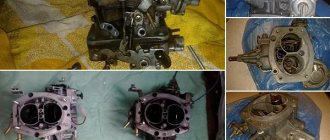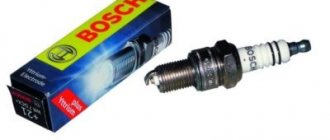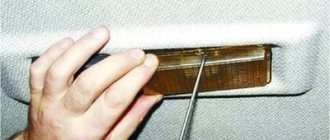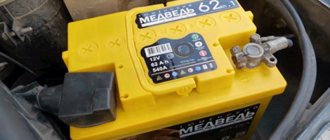A foggy windshield is, of course, not uncommon, but it’s still unpleasant. Wiping it with a regular rag is simply useless. Limiting the driver's view while driving is fraught with an emergency situation and it is better to wait until the glass is cleaned or speed up the process by any means. This article will look at why car windows fog up and how to deal with it.
Why do my car windows always sweat?
Causes of window fogging
The reason for this very unpleasant phenomenon is the physical process of moisture condensation on a colder surface. Water vapor in the air is deposited on parts in the form of droplets. For a car, this may be relevant in several cases:
- in the cool season: spring, winter, autumn;
- in the rain. Wet clothes, rugs, and covers increase condensation many times over;
- when washing a car;
- tipsy passenger (transitory effect). Alcohol vapor absorbs moisture and condenses on the windows;
- poor stove performance. This means a faulty tap, clogged stove channels or insufficient antifreeze level;
- thermostat malfunction;
- antifreeze leak. If the heater radiator is faulty, antifreeze mixes with air and is deposited on the windshield in the form of a thin oily film that never disappears.
There is nothing surprising here, and no matter how hard you try, you will never be able to prevent the windows in your car from sweating. But this effect can be minimized and some practical advice will be considered.
You need to understand that the higher the temperature in the cooling system, and the interior heating system is working properly, all the causes of condensation formation are minimized.
All the reasons why the car windows sweat inside the cabin are related to elimination methods.
What to do if the windows are already fogged up
The most reliable, although not the fastest, is to warm up the engine and let the standard heater do its job. And in order not to waste your time on this, install an alarm system with an auto-start function on your car or an autonomous heater that works according to a timer, program, or is started remotely. By the time the driver and passengers arrive, there will be no traces left of interior frost and dew.
You can do it even simpler - wipe the glass, but not with a rag, since fogging will return immediately, but with a product that leaves a thin protective film. For example, with regular newspaper or a weak soap solution with a minimum of water. To maintain transparency, the protective layer will have to be rubbed.
Turning on the air conditioner will help dry the air. It can not only lower the temperature, but also remove excess moisture from the air. But on some cars it will not be possible to turn it on at low temperatures.
How to get rid of fogged windows
In winter, car windows sweat a lot, especially in severe frost and at night. Modern cars, unlike earlier “classics,” are less susceptible to fogging. In addition, many models have a heated windshield function. But if there is no heating, and the stove is faulty or there is poor air access into it due to a clogged filter, then condensation will quickly form in the cabin.
What to do in this case? Check the antifreeze level in the cooling system to see if the cabin filter is clogged with dust and the radiator is not clogged with debris. A not fully open radiator tap is also the cause of poor interior heating. There was an article in more detail about the poor operation of the stove.
The main thing that causes your car glass to freeze in winter is a malfunctioning thermostat. A stuck thermostat in the open position will not allow the engine to heat up to the required temperature. Due to the low temperature, the windshield and side windows will constantly freeze. And the higher the speed and the stronger the frost, the worse the situation.
Insufficient engine heating due to a faulty thermostat, the cause of foggy windows
Wet weather and rain
In spring and autumn, of course, it is warmer, but still, due to the temperature difference and high humidity, condensation forms quickly. Here, to make the windows sweat less, try to keep the interior dry, especially the floor mats.
These recommendations are suitable for rainy weather. But it is enough to turn on the glass blower or turn on the heater and the problem is solved. A slightly open window can solve the problem; of course, in winter this is not an option.
Excessive fogging is caused by car washing. Here you need to dry the interior. To do this, turn on the interior heating or open the windows slightly. Both climate control and air conditioning can cope with this by setting the necessary parameters.
System malfunctions
They have all already been named; these are poor performance of the interior and glass heating, as well as a malfunction of the thermostat. It is necessary to take care in advance about their serviceability.
Additional heating
If the system is working properly, but the windows are still fogged up, then you can use an additional heater. It is installed on a torpedo, the directed air flow to the required area evaporates moisture.
Fan heater Koto EFB‑220
Their effectiveness is not high, but installed closer to the glass they can clean the foggy area. However, keep in mind that some have a short operating time and also create a significant load on the on-board network.
Lada Priora with air conditioning
The electrical circuit of the Priora stove with air conditioning is somewhat different from the option discussed above, because in this case another complex mechanism is added. There are two types of air conditioners installed on Prioras:
- HALLA" is produced in Korea;
- Panasonic is made in Taiwan.
To immediately determine the brand of the air conditioner that is installed in your car, you need to pay attention to the button in the center of the control unit. Panasonic air conditioners have a power button, but Halla does not have such functionality.
The layout of the Priora heater with air conditioning differs depending on which company the equipment is installed. We have identified the main and most significant differences:
- The Panasonic compressor uses a 120 cubic meter rotor blade. cm, and in Halla it is axial, with five pistons, with an inclined washer and a volume of 160 cc. cm.
- Panasonic uses a condenser with a receiver and a fan attached to the body, while the Korean equivalent uses a condenser with a receiver and two paired electric fans attached to the radiator. The refill volume in the Halla air conditioner is 100 g larger.
- The air distributor in Panasonic uses a standard original one, located in the cabin, while in the analog version it is equipped with a gearmotor.
Anti-fog products
The special products on sale today are quite effective, and there are a huge number of them. These are sprays, liquids or wipes. It is unrealistic to list them all, but here are a couple of the most popular ones: Sonax and ABRO anti-fog products.
Industrial means to prevent glass fogging
The working substance of the products is alcohol. Glass treated with an anti-fog agent repels moisture particles or collects them into large drops, which less interferes with the view.
The windshield fogs up from the inside - how to fix the problem?
Any motorist, regardless of what kind of car he drives, has encountered such a problem, insignificant at first glance, which is the fogging of car windows. Contrary to popular belief, the prerequisite for this phenomenon is alcohol not consumed by the driver or passengers, although this factor contributes to an increase in the intensity of fogging.
Folk remedies
If it is not possible to purchase special equipment at a car store, then you can use folk remedies, although less effective, but cheap. Here are a few ways to prevent fogging:
- Shaving foam or gel. Apply a thin layer and rub over the glass.
- Soap. Apply a fine mesh onto the glass and rub with a rag.
- Salt. At the very least, poured into bags helps. If you rub it, it dissolves ice on glass well.
It is clear that foggy windows in a car are a common occurrence caused by the difference in temperature between the interior and outside air, as well as increased humidity in the cabin. During normal operation of the heating or ventilation system, fogging is eliminated fairly quickly. In winter, you need to warm up your car.
How to properly clean a windshield?
- Use microfiber cloths or sponge.
- It is better to wipe car windows at an angle - this leaves fewer streaks.
- In winter, it is necessary to clear the glass of ice not only for viewing purposes. Snow on the glass and hood melts, and water can leak through the radiator.
7 reasons to order glass installation from us
- Property
Manufactured using high-tech automatic equipment and comply with international standards. - Professionalism
The service employs experienced craftsmen, so installing auto glass in Moscow takes a minimum of time. - Selection
There are more than 5,000 items of auto glass in stock. We are likely to install auto glass on foreign cars of the rarest models. - Reliability
Our company has existed for 13 years. - Convenience
You can sign up for a car service in advance, at a time convenient for you. - Headlight polishing
When you come to us, you can also order car headlight polishing. - Experience
We have already successfully installed more than 40 thousand glasses!
Why do windows sweat?
Let's figure it out. There are only three main reasons:
- Large amount of moisture
- Poor ventilation
- Malfunction of the heating (air conditioning) system
I recently had such a case - a cheerful group was sitting in a car, it’s cold outside now, but it’s just right there. They drank alcoholic drinks and there were 4 of them there, the stove was working and it couldn’t cope! And they were surprised - why do the windows fog up because the car is almost new? There are several reasons - it’s cold outside, there are a lot of people, beer was spilled on the rugs (that is, moisture), and alcohol, which quickly settles on the glass.
So if you drink in the car , then you shouldn’t be surprised. BUT this is a lyrical digression; now I will look into serious issues.
Tags: lada priora, “the heater does not blow on your feet or on yourself”
Comments 19
What helped me was removing the brand from the battery, I waited about 5 minutes, put it on and it started blowing in all positions.
oooooh! I need to try this method!)))) thanks
well this is the simplest so you can try this method
in the link above there is a photo with a rubber band, I did the same for myself, only I used a spring, it also didn’t blow anywhere except my forehead, now it’s normal
Great idea with the spring!)))
There is no need to remove anything. In addition to the center console and on the left you will see the thrust from the motor gearbox. Either it flew off or jammed. Move her. For example, I used natfil to shamanize her path where she walks. Now he runs like clockwork.
Either the heater control unit or the damper unit, and to understand it, removing the panel, since the beginning of winter I have already changed 4 pieces, the plastic bushings fly out and the dampers begin to jam.
you're out of luck. did you come up with a solution to the problem?
There’s no need to disassemble anything, don’t rush, it happened to me, I drove it under warranty and stood next to it while the guy tinkered with it in 5 minutes, he did it, he put his hand under the steering wheel somewhere, twisted it and said the flap turned, I have some kind of rubberized one, snapped it and that’s it! now everything is like clockwork
I wish I knew where to put my hand))
Specify the type of heater. In this article I described the main faults: www.drive2.ru/communities/LPC/blog/100283/
I don’t have air conditioning)))) thank you very much, useful information)) I’ll have to take off my beard((((
This is not to say that the heating system in the Lada Priora is completely bad, but there are still some shortcomings. Therefore, with the onset of the first cold weather, the owners of this VAZ begin to eliminate breakdowns that make driving a car simply impossible. Problems can be of a very different nature, for example, the heater does not blow at your feet. In this regard, the Priora can be called a very problematic car. But not everything is so scary and doable even without the involvement of specialists.
Heater or air conditioner?
Many people mistakenly think that the interior heater is the most effective way to dry the glass. They turn it on full, but the effect (in some cases) is zero or almost zero.
But as soon as you turn on the air conditioner, the windows are instantly cleared of fog! Why does this happen?
Everything is very simple. The stove drives hot but moist air, resulting in a double effect:
Firstly , if it’s cold outside, a greenhouse effect is created.
Secondly , if the air in the cabin is humid, it is not dried, but circulates in a circle
The air conditioner drives precisely cold and dry air; to put it in simple words, it dries out moisture from the glass, which immediately affects visibility.
But there is one “BUT”! The air conditioning system can operate down to -5, -7 degrees, and then will not turn on automatically. That is, it will help you in the fall, but not in winter.
That is why on some cars there is a so-called “anti-fogging” system (can be turned on by a separate button), and it forcibly turns on the air conditioning system.
Cabin filter
All modern cars, including domestic ones, are equipped with this (Chevrolet Niva is no exception). The cabin filter helps prevent dust and dirt from entering the vehicle. The manufacturer recommends replacing them once every 20 thousand kilometers. If the car is used in extreme conditions (for example, frequent driving on dirt roads), this period must be reduced to 8 thousand.
Some premium cars, for example the Mercedes S-Class, are equipped with a carbon cabin filter rather than a paper one. It fights pollution better, but its price is 10-15 times higher than usual. By the way, the replacement schedule is 50-100 thousand kilometers. A dirty cabin filter can reduce air flow in the ventilation system.
Plaque on glass
From high mileage, as well as from malfunctions (more on them a little later), a certain coating can form on the glass. From breathing, from dust, etc. the glass can become overgrown with a thin film - a coating, of course, may not be so visible, but if the glass has not been wiped for a very long time, then it really looks like fogging.
The bottom line is, wipe and clean the glass at least once a year before the autumn-winter period. Moreover, this must be done with both the front and rear glass.
A LITTLE ADVICE . The plaque “sits” quite well; not every product and not every rag or napkin can remove it.
We take paper towels and ammonia (it can be diluted with water). Apply alcohol to a cloth (any cloth), wipe the surface, then wipe everything dry with paper towels.
If you can’t stand the smell of ammonia, then you just need to buy an optical cleaner (sold at any electronics store) and apply it. Then again, use paper towels to remove the plaque.
Well, now about the fight against fogging.
Folk remedies: what can you rub on the surface of windows to prevent fogging?
We are talking about long-proven methods for removing condensation from glazing. An experienced driver always carries some of the funds with him. In addition, most of them are sold in regular stores.
If the windshield fogs up from the inside, use:
- Regular table salt. Rub the solution onto problem surfaces. As a preventative measure, place dry product in bags on the center console;
- Lemon. Take half a citrus fruit and wipe the glass with it. Fogging will stop, and you will get a pleasant aroma in the cabin;
- Soap. It doesn’t matter whether it’s household or toilet. Apply any shapes, drawings and lines to the surface. Use a damp cloth to wipe the glass over the entire area;
- Shaving cream or foam. Used exactly like soap. But the process, thanks to the semi-liquid state of the product, goes faster;
- A solution of alcohol in glycerin, in a ratio of 1:20. Treat surfaces with a cotton swab, a clean rag or a spray bottle. Any spray bottle that is used to spray plants is suitable for this.
Before using any of the above methods, the inside of the glass must be wiped with a cloth, sponge or newspaper. This is necessary to remove dirt and moisture from the surface of the glass.
Large amount of moisture
It happens that it’s pouring rain, you constantly get in and out of the car, carrying water on your shoes and clothes (and humid air) with you. As a result, your rugs turn into mini pools (literally full of water), it spills onto the interior insulation (under the rug), and it also gets wet. And your standard furnace or air conditioner can't handle it.
This is a standard situation. You just need to get rid of this moisture in the cabin, stop in a dry parking lot, and at least just pour the water out of the mats. Ideally, you need to dry the interior insulation, but for this you need a warm box.
Keep an eye on the interior of the car, do not let it get wet, there will be much less fogging.
The body is twisted
If it's a matter of body geometry, you can't handle it yourself, unless you're a professional straightener. Straightening the geometry is a very delicate job; even fractions of a millimeter can be important here. If the glass leaks for this reason, there are no options - you need to look for a good straightener and prepare a tidy sum. Of course, it is worth straightening the geometry only if the cost of straightening does not exceed the cost of the car itself (and this also happens). It is worth correcting the body only if your car is new and not cheap.
Poor ventilation
Or, on the contrary, too good. Mostly our OLD domestic VAZs suffered, but it often manifests itself on budget foreign cars . There are two options here:
- They broke it, like they “improved” the interior . This is when, for example, they “make noise” (make additional noise insulation) of some domestic VAZ (for example, 2114, 2112, etc.) and seal up, at their discretion, all unnecessary holes (which are placed in the body for ventilation). As a result, the car becomes like a thermos that doesn’t breathe at all, and excess condensation is “right there.” He simply has nowhere to go, and such craftsmen then rack their brains about what to do?
- Wear of seals, the body itself . It happens that due to high mileage, the seals of the doors, trunk (or fifth door) wear out. Through them there is an excessive intake of cold or damp air (sometimes even moisture can pour into the cabin). Well, this happens, the body completely rots, that is, there are straight through holes. And this again disrupts the body ventilation designed by the factory.
There are two pieces of advice here: don’t break or mediocrely improve the interior (everything has already been thought out for you). Well, if the seals are worn out, replace them, it’s not that expensive.
Do your car windows sweat when it rains? There is a solution!
Car windows sweat in the rain
- yes, it’s a well-known problem... And a very unpleasant one, since it interferes with safe and efficient driving. Why do car windows sweat when it rains and how to deal with it?
Ways to fight:
It is generally accepted that the best way to combat window fogging during rain is with an air conditioner or climate control system. Turning them on effectively eliminates the problem of foggy windows in just half a minute. The secret is simple - the air conditioner dries the air.
However, there are situations when it rains for several days in a row. Don't drive with the air conditioning on all the time. And to be honest, during the rainy season it’s no longer hot, to put it mildly. And in some cars, let’s be honest, a working air conditioner “takes away” quite a noticeable amount of “horses” from the engine, causing a certain discomfort. And on top of that, using air conditioning to combat window fogging often has a downside - when you turn off the air conditioner, the windows in your car begin to sweat again, often even more than before you turned it on.
Another very common cause of heavy fogging of windows in the rain can be a clogged cabin filter. Many car owners, after replacing the cabin filter for several months, forget about the problem of windows fogging up during rain.
But, unfortunately, this rule does not always work; a lot depends on the model of your car, the quality of its build and, in particular, the ventilation system.
Heating, which is equipped in many modern cars, helps a lot in the fight against fogging of the rear view glass. The same applies to the heated windshield.
The most ancient ancient method is to constantly wipe foggy windows with a rag. I wiped it, drove 300 meters, wiped it again. However, we will not seriously consider this method, since you can rub the windows endlessly, but they have been sweating and will continue to sweat all the way.
Need to remember.
- One of the first rules for combating window fogging in the rain is the correct setting of interior ventilation. First of all, you need to remember that in the rain you need to turn on the air intake from the street and direct the airflow onto the windows. If you leave the recirculation mode, that is, air intake from the cabin, the windows will begin to sweat even more. In especially severe cases, the airflow can be turned on to maximum. True, in some cars the sound of a running fan can drown out even the roar of the engine. But fighting window fogging requires sacrifice.
- A fairly effective way is to ventilate the interior. This allows you to equalize the inside and outside temperatures. However, driving in the rain with the windows open is not very comfortable. Firstly, it detects rain in the cabin, and secondly, if there are puddles on the street, then you can easily get a fair amount of dirt in your face from oncoming cars.
- Often, the reverse technique helps to cope with the problem we have identified - increasing the temperature in the cabin. To do this, you need to turn on the stove on heat and direct air from the deflectors to the windows, while slightly opening the window. Warm air will absorb moisture and the fogging of the windows will disappear. However, this does not always help.
Heating system malfunction
There’s something interesting to say here, without further ado, let’s start right away:
- A banal reason. The stove has broken down and is not working, either the engine itself or the fuse has failed. Needs to be fixed. Next, we will assume that everything in our electrical system is working properly.
- The glass sweats a lot. There is a sweetish smell in the interior and in the mats of an unknown liquid. Here you are 100% either leaking the heater radiator or some pipes - hoses. Moreover, antifreeze or antifreeze penetrates into the cabin. You need to take everything apart and look. It is worth remembering that coolants contain either propylene glycol or ethylene glycol , in fact these are “simple” alcohols; they also evaporate quickly and your windows will simply SWEAT VERY MUCH, no stove or air conditioner will help you. YES, breathing ethylene glycol vapor (which is included in the composition of various antifreezes G11, G12 and ANTIFREEZE ) is unsafe - IT IS TOXIC. So you need to quickly eliminate the leak (by the way, this can also lead to overheating of the engine)
Installation of deflectors
Having gained access to the space behind the bumper, we mark out future windows and cut them out with a jigsaw, grinder or other convenient tools. It should be noted that 1118 deflectors are designed for thicker seats than the thickness of the metal in the place we need. Therefore, when cutting out windows, it is advisable to provide tabs that need to be bent, thus forming thickenings of the metal, which will catch the latches of the deflectors. However, the latches are very fragile: on one of my deflectors the top pair broke. Having realized that this did not suit me, it was decided to use only the lower latches as hooks, and fix the deflector on top with self-tapping screws, which ensures complete reliability.
A couple of practical tips
I have already talked about the anti-fog glass (read this article ). It can be made from usually foam or shaving gel. They form a film on the glass, and water vapor does not settle as much!
BUT there is another, effective way - silica gel. These are balls or crystals that are often placed in boxes with shoes. The fact is that it dries the air perfectly, removing moisture (water) from it.
You say, well, okay - “where can I get it, shouldn’t I buy shoes for this?” Guys, everything is simpler, there is cat litter, silicone - this is exactly this silica gel. It can be poured into an old but not holey sock (it is important that the sock is natural and not synthetic. Synthetics do not breathe). Well, put it under the seat. You can make small bags (there are a lot of them on sale now) and put them on the panel; they will also help to “anti-fog” the front window.
Now let's watch a useful video.
This is where I end, I think my article and advice were useful to you. Sincerely yours - AUTOBLOGGER.
(
10 votes, average: 4.90 out of 5)
During the operation of the car, the driver may encounter various inconveniences. At the same time, the real problem is those that affect not only comfort, but also safety. In practice, in some cases, the headlights may be too weak even after replacing the bulbs, which makes driving at night very difficult. In such a situation, you can solve the problem by polishing the headlights or replacing them.
At the same time, not everyone knows why car windows sweat. Next, we will look at the reasons for fogging of windows in a car, when fogged glass indicates possible malfunctions of the car, and also what to do if the windows in the car are sweating.
Read in this article
Chevrolet Cruze glass sweating - Do-it-yourself car repair
Often, owners of a Chevrolet Cruze are faced with the problem of removing the rear seat. After all, no one wants to break anything despite all this, and the system there is quite narrow. Let's try to figure out how to remove the rear seat on a Chevrolet Cruze without breaking anything.
Let's start with the fact that you shouldn't remove them unless necessary. The seat fastening system in this car is quite complicated and is held on by various plastic latches. In addition, even if the seats can be removed, putting them back in place will not be so easy. It’s also not possible to remove the rear seats with your bare hands; to do this you need to stock up on some equipment.
In most cases, the rear seats on a Chevrolet Cruze are removed in order to install covers on them. After all, no one wants to send their car to the dry cleaner every time if the seats become stained. After all, you can remove the covers yourself, wash them, and put them on again. This will save both time and money. In addition, the covers allow you to significantly change the interior appearance of the car.
Chevrolet rear seat removal
In order to safely remove the rear seat from the Sherole Cruze, you need to carefully study how exactly it is attached. During the disassembly process, it is important to remember where and what was, and put all the spare parts in a separate box. The procedure for removing seats consists of as many as 5 steps; let’s take a closer look at any of them.
- First you need to remove the rear seat cushion. To do this, lift its front part and remove two brackets located on the right and left; they strengthen the cushion to the car body. After which the pillow must be removed from the passenger compartment.
- Now you need to fold the left side of the seat back forward.
- Using a 12mm socket wrench you need to unscrew the three nuts that secure the central bracket to the car body.
- We lift the left part of the backrest and move it to the left, now it can be removed from the central bracket.
- Now the left side of the seat back can be removed.
Chevrolet Cruze How to Remove the Rear Seat
The right side of the seat back of a Chevrolet Cruze car is removed in the same way. After that, putting new covers on your car will not be difficult.
The windows in the car fog up: the main reasons
So, if the car windows sweat, it often happens in winter, during rain or fog, that is, in conditions of high humidity.
Naturally, visibility in such conditions is usually poor, and if you add to this that the windshield, rear and side windows sweat, the risk of an accident increases significantly. It also happens that the cause of foggy windows is not only the weather. In any case, you need to know what to do in such a situation and what measures to take to prevent the car windows from sweating. Let's look at the causes and ways to fix the problem.
- Let's start with the simplest one. First of all, in winter, windows sweat because condensation forms as a result of the interaction of warm air inside the cabin and cold air outside. This condensation settles on the glass, causing the car windows to fog up.
- Now let's move on to the less obvious reasons why car windows sweat. For example, if there are passengers in the car who have recently consumed alcohol, then this is the reason why the car windows are sweating.
In fact, alcohol vapors exhaled by a person who drinks alcohol have the ability to absorb moisture, which causes it to settle on the car windows and fog up the car windows.
Also, problems in the interior ventilation system lead to fogging of the glass in a car. Often, we are talking about the interior air filter. Its contamination, defects, model mismatch or errors when installing the cabin filter cause the filter to not absorb moisture and dust properly. The result is foggy windows.
In fact, the damper blocks the flow of outside fresh air, and the air from the cabin circulates in a circle. In certain situations, this function is useful, as it allows you to avoid the entry of dust and unpleasant odors from the outside, the interior can be warmed up or cooled down faster by turning on recirculation, etc.
However, interior air recirculation should not be switched on all the time. If you close the flow of fresh air for a long time (20-40 minutes) or more, the windows will begin to actively sweat, and the driver and passengers may also feel drowsiness, deterioration, etc. The reason is a lack of oxygen, a noticeable increase in air humidity inside the cabin, etc.
If air recirculation is turned off, and the windows still sweat for no apparent reason, the valve through which fresh outside air enters the cabin may break. The sensor that controls the damper may also fail.
VAZ 2114 windshield is sweating from the inside, what should I do?
Dear visitors of the “Cars” website! We will be very grateful for your comments on the video clip “VAZ 2114 windshield is sweating from the inside, what should I do?” registration is not required for this. We also ask you to let us know if you have any problems playing the video.
VAZ 2101-2107 REPAIR AND MAINTENANCE.
Why do windows sweat?
07/29/2017 – 08:29 Roman Romanov.
Why do car windows sweat, several reasons, solution to the problem.
06/30/2017 – 18:12 Azeton
Silica gel in rag bags - and 5-6 more of them and spread around the cabin. You can instead use cat litter or salt as a last resort. There will be no moisture in the cabin air - no condensation on the windows. Well, shake off the snow from your feet. Water from the rugs as an enema to the street
02.06.2017 – 21:02 Alexander Pushkin
hello, please tell me how to get rid of this problem: when the damper of the stove is completely closed, warm air still blows from the nozzles, what is the problem, tell me where to go and what to do
05/22/2017 – 15:33 sergeu hrulev
Roman, thanks for the video. Good luck
05/03/2017 – 21:50 Mikhail Kontanistov
They forgot to say that only the original stove heats. All others do not heat.
04/16/2017 – 02:35 Sergey Pluzhnik
don’t spare money on the stove, it’s better to have a brass aluminum stove radiator that’s crap, you’ll only suffer
04/02/2017 – 02:03 Ivan Ivanov
Antifreeze is POISON. try not to eat GUT on the tongue
03/21/2017 – 06:20 Nurlan 777
You can also pour a special cooling system sealant into the expansion tank, if the holes are small, this should help. The sealant clogs this hole and hardens. The trick is that it comes into effect upon contact with air. And when it is in the system, it is liquid and does not spoil the cooling system in any way. It also helps with problems with an external large radiator, but this is for small cracks and holes. At least some alternative to buying a new radiator
03/16/2017 – 02:51 Sergey stal
By the way, the glass in my Lada actually sweated. I didn’t know what to do, and one fine day there was a puddle of antifreeze under my feet. I replaced the radiator and the glass stopped sweating. I just now realized why =
02/18/2017 – 13:50 Alexander Muzychenko
Roman, tell me, where are the glass wiper blades from? These aren’t VAZ ones, are they?
02/12/2017 – 06:13 Artyom Lyuty
01/25/2017 – 16:10 Alexander Kapustin
Roman, you forgot to mention ventilation. On classic sedans, valves are installed in the rear pillars; if they stop working, it is quite possible that the windows will sweat, at least the rear ones. I have a four, there are no valves and I often see foggy windows on the rear doors and in the trunk. In a cold car, the windows sweat due to the fact that during breathing a person releases moisture, which settles on the windows. To get rid of fogging when it’s cold, just open the window a little or turn on the heater; it’s still cold in the car.
What the driver should do to prevent the windows from sweating: ways to fix the problem
So, having figured out the reasons why car windows often sweat, you can move on to what to do in such a situation. Of course, the easiest way is to buy a rag and constantly wipe the glass before driving.
You can also constantly turn on the stove, drying the interior. The downside is the long wait for the engine to warm up during a cold start and for the windows to fog up. True, you can constantly turn on the air conditioner (if available), which quickly “dries” the air and removes moisture, but fuel consumption increases, the life of the air conditioning system decreases, etc.
Moreover, this approach of removing moisture with a rag or using air conditioner does not solve the problem itself, but only allows you to get rid of the consequences. If you need a more effective solution, below we will look at ways to avoid fogging.
The presence of glass that is less prone to fogging, as well as their heating, allows you to quickly dry the windows in your car without turning on the heater or air conditioner. Also in winter, heating the windows allows you to quickly clear the outside of the windows from ice and snow. It turns out that if the problem of glass fogging is acute for the driver, this feature must be taken into account at the stage of selecting a car.
- Let's move on. To reduce glass fogging, you also need to periodically service the heating and ventilation system of the car interior, check the operation of the stove, fan, etc. As mentioned above, you need to promptly change the cabin filter and turn off recirculation.
You can also stick a special film on the glass that resembles tinting. This film also has the property of preventing the accumulation of moisture on car windows. In addition, there is another solution - a defogging agent for car windows.
If desired, you can make your own anti-fog at home by mixing denatured or ethyl alcohol with glycerin. The proportions are 20:1, where 1 is glycerin. Then it is better to place the mixture in a spray bottle for ease of application.
The dangers of fogging car windows
At first glance, foggy windows in a car seem like nothing. They can be easily wiped off. Anyone would say that, but not the driver. Sitting behind the wheel of a car, it becomes clear that it is often impossible to wipe the glass while the vehicle is moving.
Any unnecessary movement, and even more so, distraction from the road, will easily cause an accident. Foggy windows in themselves do not seem to be a serious problem to the average person. The driver will again disagree with the vision of the problem.
Fogging, even a little fog, can seriously affect your view of the road. Again, the risk of accidents increases. No one can like this.
How to remove moisture from car windows quickly and effectively
First of all, if there is snow or ice on the glass, you first need to wait until it thaws, then the glass should be cleaned. While the ice is on the glass, it will sweat from the inside even with intense blowing of warm air.
To quickly clear the windshield and side windows from fogging, you first need to ask everyone to get out of the car (if there are passengers), then wait until the heater starts blowing barely warm air.
Next, turn off the air recirculation function (if equipped), allowing fresh air to enter from outside. By adjusting the deflectors, try to direct the warm air flow towards the glass.
However, in cold winters you need to be careful, as a sudden change in temperature can cause the glass to crack. To prevent this from happening, after removing snow and ice, you should gradually heat the glass, increasing the temperature.
In this case, there is no need to heat the engine and stove, since the temperature of the air blown onto the glass does not have a strong effect in this case. To prevent the rear window from sweating, its heating must be turned on immediately along with the engine.
After the windows have been cleaned, you can turn on recirculation to prevent the windows from sweating further during the trip. However, increased humidity in the cabin can cause windows with recirculation turned on to fog up again. In this case, you need to try options depending on the situation.
Function of the EGR (exhaust gas) valve
When and in what quantities exhaust gases are sent to the external gas recirculation system is controlled through the exhaust gas recirculation valve - often called the exhaust gas recirculation valve (EGR) - or EGR.
The EGR valve usually consists of a poppet valve or a special gate valve. This valve releases or prevents the movement of exhaust gases into the engine intake tract.
Using sensors such as the mass air flow sensor and oxygen sensor (lambda probe), the engine control unit calculates the ideal amount of exhaust gas recirculation and accordingly controls the exhaust gas recirculation valve (EGR valve).
The mechanical movement of the EGR valve device is usually performed electro-pneumatically or electrically using a servomotor.
On some vehicles, the EGR valve is also equipped with a position sensor that monitors the correct opening and closing of the flap or pushrod. By the way, exhaust gas recirculation occurs only in the part-load region of the engine.
Useful tips
As you can see, in order for the car windows not to sweat in the rain or snow, an important condition is to ensure the most effective ventilation of the interior. In practice, sometimes, instead of waiting for the stove to dry out the moisture, it is better to open the windows a little.
To dry the rear window, you can turn on the heating. If this does not help, then you can install a small fan or interior heater that runs from a car outlet or cigarette lighter.
Also, you should not leave wet or damp things (umbrellas, shoes, jackets, etc.) inside the car. In this case, as it dries, moisture will settle on the glass. It is also recommended to drain the water and thoroughly wipe the rubber mats; heavily wet fabric mats should be removed from the car and dried separately.
Also, especially if the car is in high humidity conditions for a long time, you need to dry the entire interior. This can be done by placing the car in a warm garage or secure parking lot for several days with the windows slightly open.
If the windows sweat while driving and the heater and/or air conditioner cannot cope with the fogging, it is recommended to drive with the side windows slightly open. Also, if it’s hot in the cabin and cold and humid outside, after the trip it’s better to open all the doors for 5-10 minutes so that fresh air can enter the cabin.
Let us also add that if the driver is transporting passengers who have been drinking alcohol, so that the windows do not sweat, it is optimal to ask such passengers to talk less (if possible), since the alcohol vapor they exhale causes the windows to fog up.
Finally, we note that you should not try to remove frozen ice from the glass using windshield wipers. This can not only damage the wiper blade, but also scratch the glass itself.
To quickly remove ice from glass, it is better to use brushes, carefully remove the ice with a scraper, or use anti-ice products for glass. It is strictly forbidden to pour hot water on frozen glass! In this case, the glass may burst immediately!
Let's try to figure it out.
To understand why car windows sweat when it rains , just take a school physics course. When it starts to rain outside, its cold drops fall on the car windows, thereby lowering their temperature. At the same time, the air inside the car remains warm and all the moisture contained in it (and during rain, especially prolonged rain, there is always an abundance of it) instantly condenses on the cold windows.
Car windows sweat especially heavily if there are several passengers in the cabin. The warm, moist breath of four or five people in a confined space can cover all the windows of a car with a thick veil in a matter of seconds. And if someone goes “after yesterday,” then the situation worsens even more.
How to remove fogged glass
To quickly dry the air, you can use not only a stove, but also a car air conditioner. Naturally, if such a function is available in the car. You can use air conditioning in both warm and winter seasons. By switching the device to warm mode, you can quickly eliminate the problem of window fogging. Using an air conditioner as soon as possible will help dry the air in any weather outside the window.
Then the driver must check that the damper on the outside air intake is open. To dry the interior air as quickly as possible, it is necessary to use the air from outside the car. It's very easy to check. The car owner will be required to turn on the heater fan to the maximum speed position and use a button or lever to switch the air intake damper
It is necessary to pay attention to the strength of the air flow entering the windshield. When the switch is in the outside air intake position, the flow will be felt much stronger than using air from the cabin
In addition, the sound power of the fan will also change.
If there is no change during switching, then most likely the damper will need to be repaired. Modern vehicle models are also equipped by manufacturers with a function for automatically taking in outside air, which is activated when you press the blower button.
To cope with fogging of the windows in the cabin, it is worth using the air blower exclusively on the windshield, and also slightly open the deflectors aimed at the door windows. In this case, the air should not be cold, and only heated air should be supplied to the windshield. When barely warm air enters the front window at engine operating temperature, but the control is turned to the maximum position, most likely the car has problems with debris in the heater radiator, or the damper on this radiator is not fully open.
If the air flow is weak when the fan is running at maximum speed, then the problem may lie in a clogged cabin filter. In this situation, we change the part. This problem occurs when the choke cables are incorrectly adjusted. The problem with the damper also manifests itself when air blows into several air ducts at once that do not correspond to the damper position mode. The driver must check when switching the dampers whether air will blow on the glass and not into the deflectors on the sides or at the feet of the passengers. If a motorist discovers a problem with the dampers, then only a specialist can help fix it.
Glass treatment products
Special glass treatment products can help reduce or completely eliminate window fogging. They are applied only to a clean surface, often after a complete cleaning of the interior in a specialized center or after self-cleaning.
If you wash the interior yourself, you should pay attention to the following points:
if cleaning is carried out in cold weather conditions, then the water should not be very warm; It is worth paying special attention to the hygiene of seals on glass; After wet cleaning, carefully remove particles of moisture from the entire surface of the cabin, paying special attention to fabric surfaces - seat upholstery and covers on them, as well as rubber mats and the space under them.
Chemicals
When choosing special products to prevent condensation, you need to pay attention to their composition. They can also be thicker or lighter, vary in duration of action and packaging volume
The following chemicals are distinguished:
- Aerosols. Convenient to use. They are sprayed at a short distance, then rubbed into the surface with a rag. The result is a thin film that prevents condensation from collecting.
- Napkins. They contain special impregnation and alcohol, which effectively removes particles of dirt and dust.
- Film. It is used to cover the glass from the inside. Does not interfere with full visibility and copes well with the problem of fogging.
- Anti-fog. Apply in one layer. It contains alcohol, glycerin and water-repellent particles.
As a rule, it is enough to apply a special product to the glass 1-2 times a week.
Note. Chemical products often contain aromatic additives that eliminate unpleasant odors in the car and increase the comfortable environment
Reasons why car windows sweat.
Condensation on glass is a product of an extraordinary physical phenomenon and occurs as a result of steam condensation, in other words, vaporization.
It is in view of this that, one and all, drivers do not attach much importance to the wet windows of their favorite iron horse, considering it an ordinary phenomenon, although there are several reasons for condensation on car windows. So: fogging of car windows, why it happens and what to do:
1. In the cool and winter seasons, the windows in the car become covered with perspiration due to the sharp difference in temperature and humidity between the car interior and the street. The warm air of the car interior interacts with the cold air brought into the car from the street, as a result of which the windows are covered with a thin layer of condensation.
2. This also happens in wet weather, during rain. The reason is not uncommon - the humidity in the cabin increases due to the evaporation of moisture from wet mats, wet clothes of the driver and passengers, and car seats. The stove dries things out, and the evaporating moisture covers the glass with condensation. In addition to wet rugs and clothes, the source of perspiration can be damage to the windshield insulation or damage to the integrity of the car door seals.
3. Contamination or malfunction of the cabin filter, as well as its rare replacement and cleaning, leads to deterioration of air conductivity, and as a result, this is a problem.
4. The windows of your car may also sweat if the valve or sensor that regulates the normal operation of the valve flaps breaks down. Due to these problems, no air flows into the cabin.
5. An oily film on car windows is a dangerous signal of a leak in the radiator, under the dashboard of the car and one of the reasons for foggy windows.
6. Washing your favorite car - moisture gets inside the cabin, but it doesn’t have time to dry.
7. A “cheerful” passenger who is in a tipsy state is also, albeit transiently, the cause of fogging of car windows. Alcohol vapor absorbs moisture and settles on the car windows in the form of condensation.











